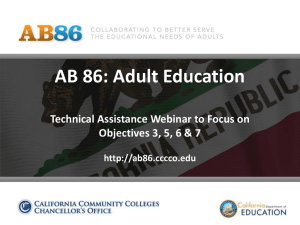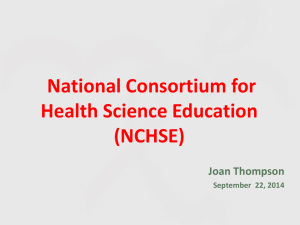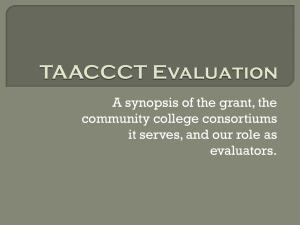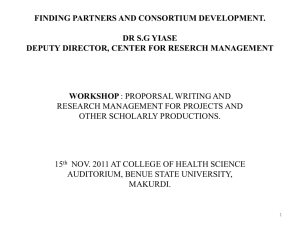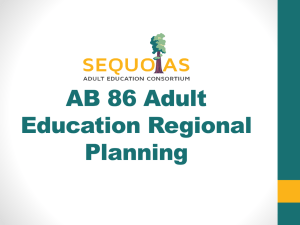APPENDIX C: Template for Regional Comprehensive Plan
advertisement
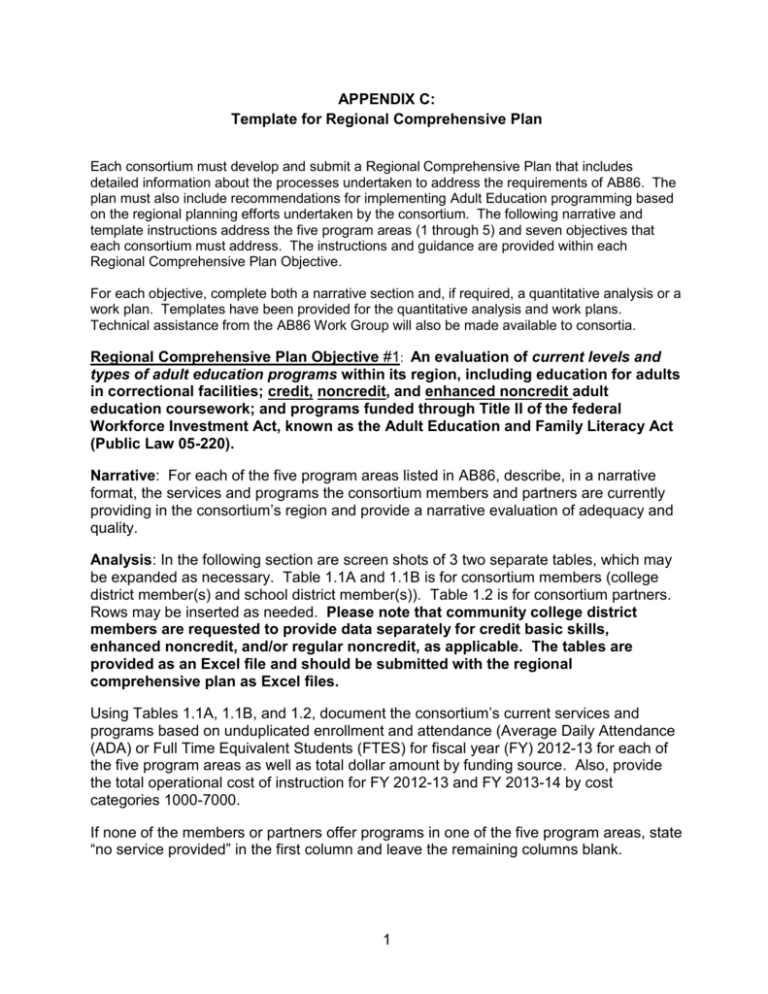
APPENDIX C: Template for Regional Comprehensive Plan Each consortium must develop and submit a Regional Comprehensive Plan that includes detailed information about the processes undertaken to address the requirements of AB86. The plan must also include recommendations for implementing Adult Education programming based on the regional planning efforts undertaken by the consortium. The following narrative and template instructions address the five program areas (1 through 5) and seven objectives that each consortium must address. The instructions and guidance are provided within each Regional Comprehensive Plan Objective. For each objective, complete both a narrative section and, if required, a quantitative analysis or a work plan. Templates have been provided for the quantitative analysis and work plans. Technical assistance from the AB86 Work Group will also be made available to consortia. Regional Comprehensive Plan Objective #1: An evaluation of current levels and types of adult education programs within its region, including education for adults in correctional facilities; credit, noncredit, and enhanced noncredit adult education coursework; and programs funded through Title II of the federal Workforce Investment Act, known as the Adult Education and Family Literacy Act (Public Law 05-220). Narrative: For each of the five program areas listed in AB86, describe, in a narrative format, the services and programs the consortium members and partners are currently providing in the consortium’s region and provide a narrative evaluation of adequacy and quality. Analysis: In the following section are screen shots of 3 two separate tables, which may be expanded as necessary. Table 1.1A and 1.1B is for consortium members (college district member(s) and school district member(s)). Table 1.2 is for consortium partners. Rows may be inserted as needed. Please note that community college district members are requested to provide data separately for credit basic skills, enhanced noncredit, and/or regular noncredit, as applicable. The tables are provided as an Excel file and should be submitted with the regional comprehensive plan as Excel files. Using Tables 1.1A, 1.1B, and 1.2, document the consortium’s current services and programs based on unduplicated enrollment and attendance (Average Daily Attendance (ADA) or Full Time Equivalent Students (FTES) for fiscal year (FY) 2012-13 for each of the five program areas as well as total dollar amount by funding source. Also, provide the total operational cost of instruction for FY 2012-13 and FY 2013-14 by cost categories 1000-7000. If none of the members or partners offer programs in one of the five program areas, state “no service provided” in the first column and leave the remaining columns blank. 1 Table 1.1A Screen Shot (see Excel File for Template) 2 Table 1.1A Screen Shot Continued (see Excel File for Template) 3 Table 1.1B Screen Shot (see Excel File for Template) 4 Table 1.2 Screen Shot (see Excel File for Template) 5 Regional Comprehensive Plan Objective #2: An evaluation of current needs for adult education programs within the consortium’s region. Narrative: Describe and assess current needs for each of the AB86 adult education program areas (1-5), including the needs that are currently unmet. This might be informed by regional data including, but not limited to, student wait lists for classes in the program areas addressed in AB86; school districts’ K-12 English Learner statistics; the number of children who qualify for free or reduced lunch; adults who do not have a high school diploma; and other relevant data. Additionally, consider needs in your region documented in state sources that informed the AB86 awards, which were calculated based on community college district boundaries (http://cccgis.org/CCCDistrictBoundaries/tabid/626/Default.aspx). The plan narrative should provide an overview of the consortium’s region including: ● Analysis/description of local regional economy ● Additional analysis utilizing other data Analysis: In the following section are templates for summarizing the past, current and projected enrollment of consortia members and partners in each of the five program areas. Rows may be inserted as needed. Table 2 is for documenting the past, current and projected enrollment in each of the five program areas defined by AB86. This table will be submitted as an Excel file with your regional comprehensive plan report due July 31, 2014. 6 Table 2 Screen Shot (see Excel File for Template) 7 Regional Comprehensive Plan Objective #3: Plans for consortium members and partners to integrate existing programs and create seamless transitions into postsecondary education or the workforce. In responding to this objective, the consortium will document the plans to align and connect existing and future adult education programs to postsecondary academic pathways and/or career pathways leading to employment. Plans should address how the consortium will align placement tools, curriculum, assessment tools and rubrics, and student performance outcomes across delivery systems to ensure that student transition paths, both between providers and into postsecondary credit programs, are understood and supported across all systems. Plans to facilitate transitions from adult education to college or career should include a description of program alignment and pathways. Plans should also address support services needed to ensure that students have access to educational advising and that they develop educational plans to help them move toward their academic and career goals. Narrative: Describe the specific plans and strategies the consortium will employ to create the following: ● Educational pathways ● Alignment of: ○ Placement ○ Curriculum ○ Assessments ○ Progress indicators ○ Major outcomes - i.e., awards of high school diplomas, CTE certificates, etc. ● Transition strategies among the consortium participants’ systems including: ○ Communication paths among consortium participants and higher education institutions ○ Defined and articulated pathways to postsecondary education or the workforce ○ Embedded access to student services including counseling, guidance, and follow-up Table 3.1 is a work plan for documenting these strategies and approaches the consortium plans to implement to establish efficient pathways and transitions among consortium participants. 8 Table 3.1: Implementation Strategies to Create Pathways, Systems Alignment and Articulation among Consortium Participants Transition to be Addressed Strategy/Approach to be Employed Resources Needed Estimate of the Cost 9 Responsible Parties (specific school districts and/or community colleges) Methods of Assessment Timeline Regional Comprehensive Plan Objective #4: Plans to address the gaps identified pursuant to paragraphs (1) and (2). Describe how the consortium intends to respond to the gaps identified in the region. These might include, but are not limited to, working with other partners in the service area, developing or expanding programs and plans to assess the effectiveness of these expanded efforts. Plans should identify programming and service gaps including lack of providers, services, access, attainment, and/or performance. Plans should also include strategies to incrementally increase capacity in identified gap areas (e.g., using distance learning to reach adult populations in a consortium’s region who are currently underserved). The plan should include sufficient detail including: A description of the resources needed to implement the identified strategies. Identification of the methods and common metrics needed to track the successful implementation of the plan and measure the amelioration of identified gaps in services/programming. In addition to the narrative, complete the work plan (Table 4.1) on the next page to summarize the identified gaps/needs, what strategies will be employed to address the identified gaps, the resources needed to carry out those strategies, the costs involved, the consortium participants responsible for implementing the identified strategies, the methods for assessing the progress made toward implementing the identified strategies, and a timeline for accomplishing the various .implementation steps. 10 Table 4.1: Implementation Strategies to Address Identified Gaps Description of the Gap Strategies to Address the Gap Resources needed Estimate of the Cost 11 Responsible Parties (Specific school district(s) or college(s)) Methods of Assessment Timeline Regional Comprehensive Plan Objective #5: Plans to employ approaches proven to accelerate a student’s progress toward his or her academic or career goals, such as contextualized basic skills and career technical education, and other joint programming strategies between adult education and career technical education. Research has emerged in recent years identifying practices that reduce the time it takes for adult learners to progress through basic skills and career education pathways. Common strategies include compressing courses into shorter, more intensive terms (accelerated), individualized instruction based on a student’s competencies (competency-based), and putting basic skills content into the context of a student’s goals and career path (contextualized). Many examples of these “best practices” are already in place within and among California adult education and community college programs. These “best practices” are not new to faculty; in fact, they have been developed by faculty. AB86 expects that the work done by regional consortia will include plans to make use of these strategies within their basic skills and career programs and in joint programming strategies. In many places in the country, Integrated Basic Skills Training (IBEST) models, which contextualize the development of basic skills with the acquisition of workforce competency, have produced impressive data showing how learning can be accelerated while joining skills development with career readiness certifications. The AB86 website will continue to build links and resources tied to best practices and research done through adult education and community colleges. Qualitative Narrative: Identify plans to implement and/or improve specific evidencebased strategies across the region, within and between systems where they currently don’t exist, to accelerate student’s progress. Plans should address: how the consortium will identify and gather measurable improvement metrics how existing best practices and strategies such as those described earlier will be implemented for each of the program areas. Plans should include a work plan, similar to the one shown in Table 5.1, that summarize the elements of the plan, including: specific approach to be employed; specific tasks/activities needed to implement the specific approach; resources/costs involved in implementing the tasks/activities; consortium parties responsible for carrying out each task; methods for assessing the success of implementing the approach/strategy; and, timeline for completing each task. 12 Table 5.1: Work Plan for Implementing approaches proven to accelerate a student’s progress toward his or her academic or career goals Description of the Approach Tasks/Activities Needed to Implement the Approach Estimate of the Cost Resources needed 13 Responsible Member (Specific school district(s) or college(s)) Methods of Assessment Timeline Regional Comprehensive Plan Objective #6: Plans to collaborate in the provision of ongoing professional development opportunities for faculty and other staff to help them achieve greater program integration and improve student outcomes. A critical element to ensuring the effective implementation of the consortium’s plans to improve adult education programs are faculty and staff equipped with the skills, knowledge, and support needed to deliver high-quality instruction and use classroom support strategies that foster learner persistence and goal achievement. Significant and effective professional development will be required to build capacity within the existing systems to deliver this new vision for adult learning throughout the state. Faculty and staff from all local consortium members and partners will need to implement collaborative professional development strategies to foster alignment and to support ongoing assessment and improvement of student outcomes. Collaborative professional development plans should identify topic areas the consortium considers a priority, such as: ● Practices in basic and secondary skills that build the “college readiness” skills. ● Team building, critical thinking, problem solving, study skills, soft skills, and career assessment. ● Technology use and integration to enhance and expand technology in Instruction. ● New models and instructional strategies for contextualized and/or accelerated teaching and learning. ● Skills building intercultural competence among faculty, staff, and administrators. Examples of collaborative activities might include developing professional learning communities comprising faculty in the same content area, representing all consortium participants. Plans might also describe joint team participation in professional development activities offered through regional/statewide associations and how these teams might share what they learn with other faculty. Consortia may also want to consider having field experts come to a regional facility to provide in-house training to greater numbers of staff, faculty and administrators. Consortia in areas where transportation may pose a problem may want to develop plans to use technology to overcome that challenge. 14 Table 6.1 Current Professional Development In the table below, identify current, effective professional development strategies carried out by consortium members that could be adapted for consortium-wide use. Table rows can be added. Topic Professional Development Strategy Program Area(s) Addressed Estimated Cost to Implement ConsortiumWide Table 6.2 Collaborative Professional Development Plan In the table below, address topics the consortium considers priorities for collaborative professional development. Include, at a minimum, topics to help achieve integration among consortium members and improvement of student outcomes. Table rows can be added. Topic Collaborative Professional Development Strategy (Activities, Participants, Delivery Mode, Frequency) 15 Program Area(s) Addressed Estimated Cost to Implement Consortium-Wide Regional Comprehensive Plan Objective #7: Plans to leverage existing regional structures, including, but not limited to, local workforce investment areas. Describe how the consortium will leverage existing assets or structures to benefit the adult learners in the region. These assets or structures might include, for example, contributions from or collaborations with local Workforce Investment Boards (WIBs), industry employer groups, chambers of commerce, and county libraries. For example, a consortium might include in its plan to offer classes, taught by one of the member districts, at a local Workforce Development Center which is easily accessible by members of the community. Another consortium might opt to work with the industries in its region to develop a career transition program focused on helping students with disabilities gain the necessary skills to enter the workforce. ● Identify existing regional structures and their resources. These might include but are not limited to: ○ WIBs ○ Chamber of Commerce ○ County Libraries ○ County Office of Education ○ Industry Employer Groups ○ Literacy Coalitions ○ Economic Development Regions ○ County Social Services - CalWorks ○ Employment Development Department (EDD) ● Identify current engagement strategies and describe how these strategies leverage regional structures. ○ Outreach by regional consortia to existing regional structures ○ Utilization of existing regional resources ○ Positioning of the regional consortium to be responsive to economic needs ○ Positioning of the consortium to be stronger and more effective 16 Table 7.1 Leverage of Existing Regional Structures from Partners (expand table as necessary) Partner Institution Supporting Regional Consortium Program area to be addressed (1-5) Tasks/Activities Needed to Implement Support of the Program Member Counterpart(s) * Partner Contrib * Indicate the consortium member(s) who will be the users of the contribution. ** Partner Contributions may be in the form of cash, in-kind (i.e., facilities, staff time, etc.), or a combination of both. Please note: matching contributions are not required for a consortium’s partners or members. The purpose of this table is to identify the contributions that partners may make to the efforts of a consortium toward coordinating the Adult Education programs to be offered by the consortium.
